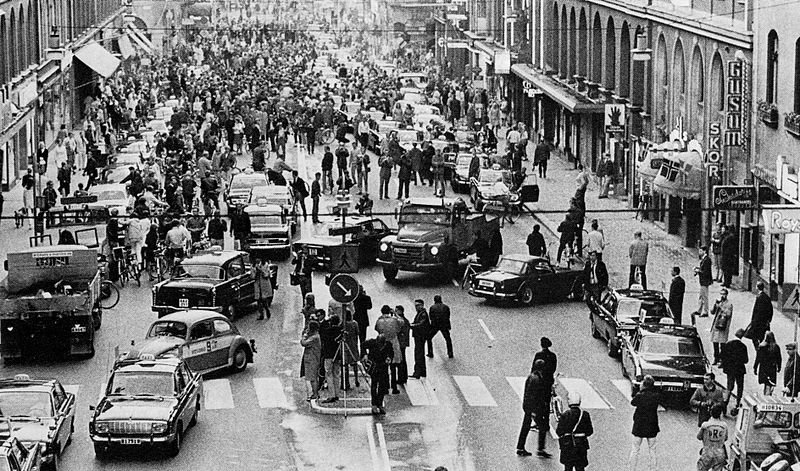Högertrafikomläggningen

If you look carefully at the pandemonium pictured above, you’ll notice something awry toward the left side. The first few cars are going one direction but, as you move backward, the cars start going the opposite way. Or, at least, they’re trying to — there are so many people in the street, no one is going anywhere, at least anytime soon. Most traffic jams like that — ones where people flood the street, that is — are caused by something unexpected, and drivers and pedestrians alike find their attention diverted toward the unpredictable event.
But this one was different. The confusion was planned — and even voted on.
The image above depicts Stockholm, Sweden during Högertrafikomläggningen, literally “the right-hand traffic diversion.” (You can call it “Dagen H,” or “H-Day,” if attempts to pronounce “Högertrafikomläggningen” fail, which they probably will. It goes by that name, too.) On September 3, 1967, the whole country of Sweden changed the way they drove. Instead of driving on the left side of the road, motorists were now to drive on the right.
Sweden made the change for two major reasons. First, in both Finland and Norway (which share land borders with Sweden), drivers drove on the right side of the road, and flipping traffic as one crossed borders proved difficult. Second, most of the cars in Sweden were built with the driver’s seat on the left (as is common in countries where drivers drive on the right), which led to accidents on narrower roadways. Combined, the flip seemed like a costly but common-sense idea.
Nevertheless, the move was anything but wanted by the rank-and-file Swede. The government first proposed the flip in 1920 but, met with resistance, held off for decades. In 1955, for example, a nationwide non-binding referendum on the matter resulted in a landslide victory for left-side driving traditionalists, with well over 80% of the 2.5 million voters opting to remain that way. But the key phrase there is “non-binding.” In 1963, Swedish government chose to switch anyway, but to do so only after a large-scale PR campaign to change citizen’s attitudes. Dagen H was turned into a social movement with its logo — seen here — blanketed on virtually everything, including commemorative women’s underwear (!), according to TIME. National TV held a contest for a Dagen H theme song. By the time Högertrafikomläggningen came, the people were ready.
The switch also required a massive amount of infrastructure changes — new signs had to be installed, bus stops had to be moved across the street, traffic lights needed to be flipped, etc. — but in general, the transition was a success. As a bonus, traffic accidents dropped the weeks after Högertrafikomläggningen and stayed low for about two years. These safety gains were probably attributable to drivers who were still getting used to the reversal of traffic, and therefore driving more cautiously, but having road rules which matched the ones the cars were designed for probably helped, too.
Bonus Fact: In most of the United States, like most of the world, drivers drive on the right side of the road. The exception in the U.S.? The U.S. Virgin Islands, which therefore has signs, such as this one, reminding people to drive on the left side.
From the Archives: Septuagenerian on Board: Driving in Japan, where your age is relevant.
Totally unrelated item: My book! (If you’ve already bought it and you liked it, please leave a review!)
